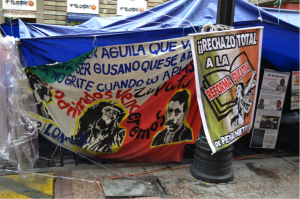After weeks of disruption for residents and workers in Mexico City, teachers protesting in Zócalo Square have been forcibly removed. Riot police used tear gas to disperse the occupiers and were backed up by armoured vehicles and helicopters. The teachers (who mostly came from Oaxaca, Guerrero, Chiapas and Tabasco) belonged to the CNTE Teachers’ Union and were campaigning against the government’s educational reform, which was passed by congress on Wednesday September 4th.The educational reform aims to improve the low standard of education in Mexico by being tougher on teachers and giving the Union less power. Protestors fear this will result in mass lay-offs for Mexican teachers.
However, the Union’s fear is not entirely justified because government proposals only pose a threat to job security in cases of incompetence. Up until now, Teachers’ Unions have had complete control over the education system. The Union has abused this power and there are numerous reports of corruption within the organization. The most notable example is the embezzlement of public funds by the SNTE (the largest teachers’ Union in Mexico) which culminated in the arrest of ex-Union leader Elba Ester Gordillo on February 26th last year, who was alleged to have stolen more than $2 billion pesos. Under the Teaching Union’s rule, jobs in education could be obtained through contacts not merit; nepotism rather than qualifications. For example, teachers had the right to sell their jobs or pass them on to their children. Cancelling classes for no reason was common and the Union did nothing to prevent it. Whereas, under the new education reform, the Union will be stripped of its budget (which will be re-directed to the government) and teacher assessments from independent bodies will become mandatory. Those who fail their performance evaluations will be given the opportunity to improve and risk being dismissed or re-shuffled if they refuse to comply. Teachers’ children will no longer inherit their parents’ jobs automatically and teachers who miss more than 3 classes in a row without an adequate excuse will be sacked.
Perhaps as a consequence of incompetent teaching, Mexican education is below par. A study carried out by the OECD in 2012 found that only 47% of Mexican students are expected to graduate from secondary school. Instead of completing their studies, the average student goes to school for 8.7 years, which means that if they were going to school in England, they would leave just after Year 8.
Furthermore, the percentage of 15-29 year-olds who are neither in education nor employed (NEET) is the third highest in the OECD area. Within this category, women are three times more likely to be NEET than men. This figure can be explained by early pregnancy. According to the newspaper La Reforma, 69 births in every 1000 are teenage births (between 15 and 19 years old) and a quarter of Mothers in Latin America gave birth when they were less than 20-years old. Mexico is a very Catholic country and most children are not taught about sexual education, except to say that sex is wrong. The President, Enrique Peña Nieto, has done nothing to address this problem or change the sex-ed. curriculum.
Other criticisms of the reform include the overemphasis on teacher assessment – which sparked the protests in the first place – and the fact that his proposal is incredibly expensive. At a time when Mexico is suffering from an economic crisis and is indebted to other countries, carrying out 800 000 teacher performance evaluations per year will be costly. Moreover, if the Union is corrupt, who is to say that the government is any more trustworthy in its handling of the education budget? We should also ask what the performance evaluations will entail. Surely a rural teacher who has to walk a long way to school and has little resources should be assessed in a different way from a city teacher with lots of material. Also, is it fair to mark a teacher in their 1st year of the job against the same criteria as a teacher who has 20 years of experience?
All in all, the Mexican Education Reform is a step in the right direction. According to Zamarripa, a columnist for the magazine Reforma, “the 2013 demonstration is a socio-political movement which epitomizes the crisis of our times”. However, the education reform is not a panacea. It is a response to the education crisis, not a solution. The quality of education here varies drastically from school to school; and is a factor which contributes to the high levels of inequality in Mexico. Currently, 43% of the population does not meet the requirements for a basic education including key skills such as reading, writing and maths. This figure is unacceptable in an increasingly competitive and educated world. Peña Nieto may have passed some new laws but he needs to do much more than that to introduce and maintain higher education standards in Mexico. Teachers need to be better educated themselves before they are let loose in the classroom. Why teach if you do not believe in learning?




